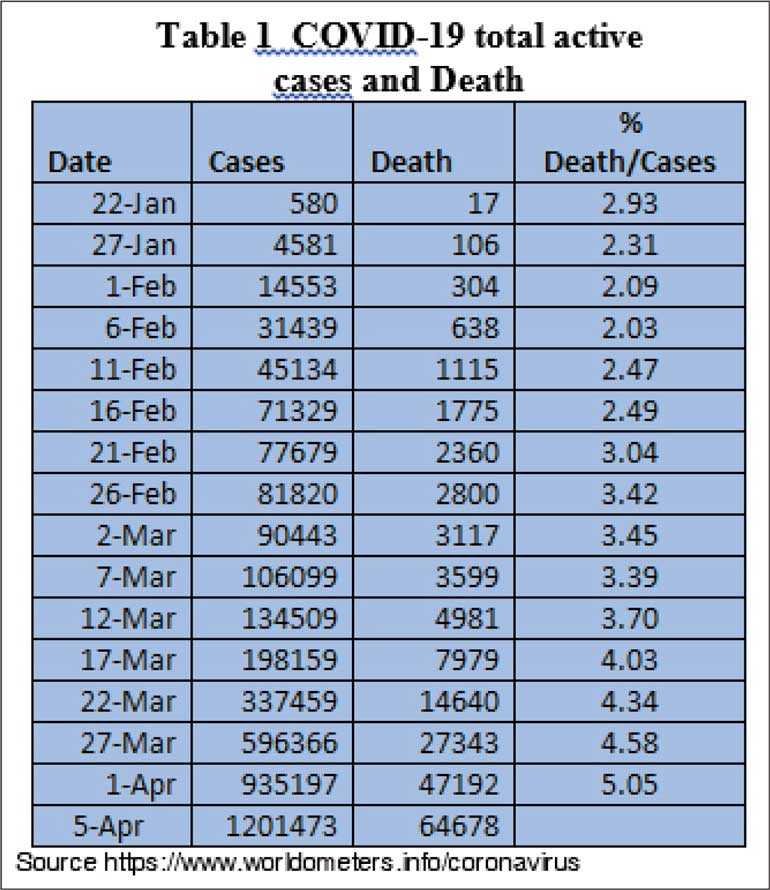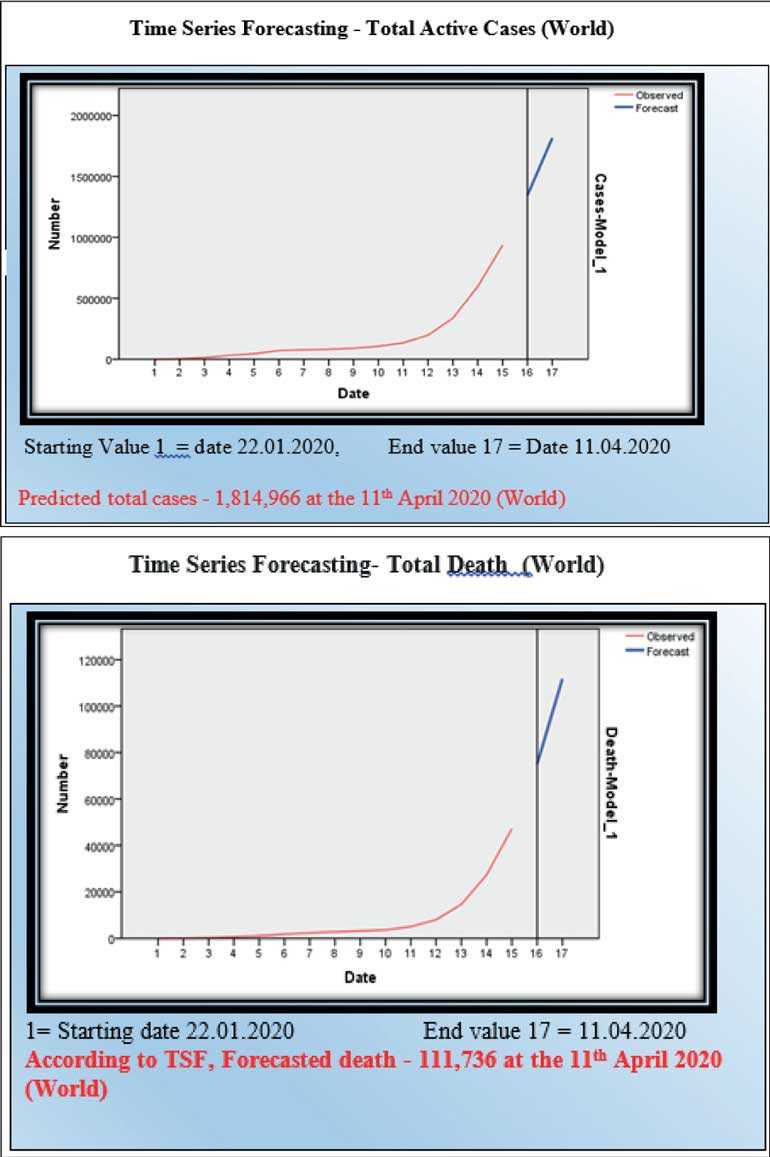Sunday Oct 19, 2025
Sunday Oct 19, 2025
Friday, 10 April 2020 00:00 - - {{hitsCtrl.values.hits}}



At present, COVID-19 has affected over 200 countries and territories around the world. Although the virus originated in China, it has now spread among all other countries. Even though the world is marching towards a technological boom, no one has been able to find a successful medicine and  remedial measures. (https://www.worldometers.info/coronavirus/)
remedial measures. (https://www.worldometers.info/coronavirus/)
Daily statistics of the COVID-19 has surprisingly increased with the highlight of USA reporting the highest number of total cases of 311,357 and; in Europe, Italy 124,632 Spain 126,168 and Germany 96,092. The average total cases in the world have increased to 154 per one million up to date while death ratio in all the infected countries has increased to 8.3 per one million (5 April).
According to the WHO data the total COVID-19 cases in the world have doubled in seven days while it doubled in five days in the United States, 10 days in Italy and six days in Spain. China where COVID-1 originated has controlled the situation and the cases double only every 50 days.
Meanwhile China has announced that it has concluded all operations against corona and it was able to reduce the total cases to 57 per one million. Compared to this the rate in Iceland has increased up to 5,152 and Vatican City 8,739 (5 April).
The Centre for Disease Control (CDC) Director Robert Redfield told CNN that it would probably be around “beyond this season, beyond this year”. Redfield conceded that the larger medical community didn’t really have a clue about what was going to happen. This is especially true, time series nonlinear forecasting model predict that total cases case scenarios of more than two million infection of world populations by mid of April, forecasting model results present in Graph 1 and 2.
Furthermore, it has found that average temperature of the countries and spread of COVID-19 significantly correlate. Correlation coefficient 0.317 is significant at 0.01 level of confidence. (Used cross sectional data from 164 countries). It may be one major case to rapidly spread the virus among the countries in Europe.
China has planned to reopen the country soon. The pandemic seems to have created a world crisis similar to the one after the Great Depression which happened during the 1930s. It is affecting the global economy through health, industries, education and service sectors.
Dynamic changes of macroeconomic characteristics
Under this situation some economists are already calling for governments to introduce measures to shore up aggregate demand. In the current situation, countries suffer from unprecedented supply shock. People are not at work because most of them are sick or quarantined. As a result of limitation of supply, demand stimulus will merely boost inflation and weak or falling GDP growth due to supply chain issues.
Estimates of the global impact of GDP in the second quarter vary: The OECD predicted that COVID-19 would lower the global GDP growth by one-half a percentage point for 2020. GDP growth could fall to zero in a worst-case pandemic scenario. As a result of depressed activity, the United Nations projects that Foreign Direct Investment flows could fall at a considerable rate, to their lowest levels since the 2008-2009 global financial crisis.
“Judging by the data, the shock to China’s economic activity from the coronavirus epidemic is greater than the (2008) global financial crisis,” said Zhang Yi, Chief Economist at Zhonghai Chenggong Capital Management.
“The COVID-19 outbreak has generated both demand and supply shocks deepening across the global economy. OECD forecasts the largest downward growth revisions will be in countries deeply interconnected to China, especially South Korea, Australia, and Japan. Major European economies will experience dislocations as the virus spreads and countries adopt restrictive responses that curb manufacturing activity at regional hubs, including in Northern Italy.
“As China is the world’s second-largest economy and a leading trading nation, their economic downturn threatens global growth. Every individual and society must give their fullest support to control the cause and Government policies would need to be focused on preventing large-scale bankruptcies and unemployment.”
The global stock market has sharply fallen after the end of February by less than -30%. Consequently, the Sri Lankan stock market began to fall since the inception of the cases.
Another considerable case of liquidity support by the financial agencies is most important. The world is already awash in liquidity, with nominal interest rates close to or below zero nearly everywhere. More interest-rate cuts into deep-red territory might help stock markets. The bank of England (BOE) announced an emergency cut to interest. The US Federal Reserve followed a similar decision last week.
Aggregate demand, supply and employment
In 1936, British economist John Maynard Keynes wrote ‘The General Theory of Employment, Interest, and Money’ to explain why the Great Depression had lasted for such a long period of time where labour markets did not seem to come into equilibrium.
For years, lots of people were looking for jobs but couldn’t find them. Keynes argued that the problem was a lack of demand for goods and services, resulting in a lack of demand for labour. The way to solve this problem, according to Keynes, was to increase government spending.
Keynes has used two key terms, namely, aggregate demand price and aggregate supply price, for determining effective demand.
In figure 4, if aggregate supply price is H and demand price is C, organisations have more profit and they can hire more workers and increase the production until N2 equilibrium level of employment. The economy would be in equilibrium when the aggregate supply price and aggregate demand price become equal.
In figure 3, both aggregate demand and supply will be sharply decreasing during corona affected period (Supply S1 to S2 Demand D1 to D2 in figure 1) Global production will decrease (Q1 to Q2) but price level will be not changed and stat at the same level at (p*) under this situation a large rate of unemployment will occur globally. The meaning of globally huge unemployment is that all production resources are not used and it will be affecting low income and it will be cause to further sharply reduce the aggregate demand.
The same case happened in the Great Depression period which happened in 1930s. But the current situation is different because unemployment occurs due to compulsory isolation of people as the solution for recovery from COVID-19 until a certain period. International organisations assume that more than 2.5 million jobs will be lost in the near future.
Keynes proposed to increase demand through increasing government expenditure to increase employment. Even though the aggregate demand increased through increasing the government expenditure, aggregate supply cannot increase as much as required level to meet full employment level of equilibrium because the global economy has shut down for a considerable period. Therefore it requires a solution beyond Keyne’s fiscal remedies. As we know decreasing the interest rate has no power to manipulate the money market and to settle-down the crisis. Hence monetary policy also will be challenged under this situation.
Presently many governments provide funds to maintain the smooth functioning of the basic necessities of the people. IMF and international organisations are going to inject money by providing loans for the affected countries. These actions are more important to push the demand in the short run but it will be affecting price increases and inflation.
Sri Lanka has introduced maximum pricing policy for the essential goods and it is managed by the government. The uncertainties ahead swing between extremes. As the shortages worsen before they get resolved, prices of many products could go up for consumers even if laws exist against price- gouging. At the same time, constrained supplies could cause declines in demand, which in turn may end up weakening prices. “All those things will happen and have already happened. There’s no magic answer here.”
Aviation and tourism industry
The World Travel and Tourism Council has warned the COVID-19 pandemic could cut 50 million jobs worldwide in the travel and tourism industry. Asia is expected to be the worst affected. Once the outbreak is over, it could take up to 10 months for the industry to recover. The tourism industry currently accounts for 10% of global GDP.
The International Air Transport Association (IATA) predicted the COVID-19 outbreak could cost airlines $113 billion in lost revenue as fewer people take flights. The travel and tourism industries were hit early on by economic disruption from the outbreak. In addition the impact on airlines, the UN’s International Civil Aviation Organization (ICAO) forecasts that Japan could lose $1.29 billion of tourism revenue in the first quarter due to the drop in Chinese travellers, while Thailand could lose $1.15 billion. Meanwhile around 600,000 employments in Sri Lanka tourism and hospitality sector will be a big challenge.
The World Tourism Organization (UNWTO) has revised its 2020 forecast for international arrivals and receipts. UNWTO has strengthened its collaboration with the World Health Organization (WHO) for future actions.
Manufacturing sector
China’s economy has spread with globalisation and it has complex supply chains, as companies worldwide came to depend on supplies from their operations. As a consequence, factory shutdowns in virus-affected provinces have resulted in shocks across a wide range of industries.
Apple’s manufacturing partner in China, Foxconn, is facing a production delay. Some carmakers including Nissan and Hyundai temporarily closed factories outside China because they couldn’t get parts. Apple experienced shortages in its iPhone supply as a result of the company's primary manufacturer, Foxconn, shutting down much of its production in China. The pharmaceutical industry is also responding negatively for disturbance to global production. Many trade, cultural and sporting events across the world have been cancelled or postponed.
If the virus continues to spread across the world regions, uncertainty and disruption will increase and factory shutdowns would unavoidably follow all over the world. Some companies might consider revising their supply chains to find alternatives for China and affected countries. But China has announced that she has controlled the situation and is going to revamp the economic activities.
Technology sector
When considering the technology sector, China is the leading exporter of electronic components, with nearly 30% of the global export market. Disruptions in deliveries are particularly harmful for countries highly dependent on electronic supplies from China. However the technological sector will be helpful to control COVID-19 in different aspects and some experiences are mentioned below.
Immediate actions taken by the affected countries
At present, the global economy is shutting down. The German Government has introduced a short-time work allowance and granted generous credit assistance, guarantees or tax deferrals for distressed companies. Public events across the country have been cancelled. Many countries have closed their borders. Schools, universities and most shops have also been closed. India, Sri Lanka and some other countries are adopting curfew and country lockdown system.
South Korea employed a central tracking app, Corona 100m, that publicly informs citizens of known cases within 100 metres of where they are. Some countries have organised distance learning for children who are at home, with priority for children who are due to take final exams this year. The Sri Lankan Government has achieved fourth place among the countries which has successfully handled the case while most highly developed European countries are becoming worst cases.
Remedial measures
Short-term and immediate solutions
The Government and private sector have been taking immediate action with the short experience in China and some other countries. KPMG has announced a package of recommendation as well as some other experts proposing strategies to mitigate global crisis. Those recommendations can be summarised as below.
Mid-term and long-term strategies to increase supply
Scenario planning:
Risk management:
Businesses have sharpened their risk mitigation tools after each successive disruption to supply chains. For example, after the 2011 tsunami, “companies like Cisco and Boeing have invested substantially in supply chain risk management policies, strategies and infrastructure so that they can be aware of [such] an event and understand its consequences,” Cohen said. “Now, there’s a fairly well-understood methodology, and most major companies have some kind of supply chain risk management process in place.”
However, those risk management processes are not healthy enough to cope with the fallout of the coronavirus pandemic, Cohen said. “This is unprecedented in its scale and in the extent of it. We’ve never seen a disruption like this where … a large number of countries are telling their populations to stay home, to not work — there are lockdowns all over the world.”
KPMG (March, 2020) has mentioned that theoretical and practical suggestions to manage supply under uncertain situation, it will be important to handle business under the situation of COVID-19 as well as any case of disasters.
(Search; https://home.kpmg/xx/en/home/insights/2020/03/medium-to-long-term-actions.html) for details
Inward-looking economic policy for sustainability
Small countries such as Sri Lanka that depend on developed countries will definitely create big challenges with this kind of situation. Our facilities and resources are very limited compared to China, Italy, Spain and America. Sri Lanka is lagging behind them and should move to self-sufficiency instead of being an open and globalised economy.
Each and every piece of land should be cultivated, and local industries such as handloom, food processing, agricultural and manufacturing need to be urgently started, expanded and developed. Sri Lanka could even control the spreading of the new coronavirus by limiting international relations for a considerable duration.
Big workforce who are in the tourism, construction and manufacturing sectors will be unemployed during the pandemic period. It may be more than two million. These unemployed should redeploy in local sectors such as biomedical, agricultural, domestic industries, supply and distribution service (e.g. home delivery and technology based new productions). Supply chains need to reorganise accordingly.
This is a big opportunity to expand production in indigenous medicine and consumable products based on local material. It is an urgent need to give attention to provide direct and immediate support to local small and medium businesses as well as micro business to ensure their efficient operation. This is the time to restate the King Parakramabahu vision to accelerate development of agriculture and domestic industries in line with Sustainable Development Goals.
[Upali Rathnayke, Navoda Edirisinghe (RO) and Uda Weerasinghe (RO) at National Human Resource Development Council of Sri Lanka, thank you for your support.]
(The writer is Director, National Human Resources Development Council of Sri Lanka, Ministry of National Polices and Economic Affairs and can be reached via [email protected])